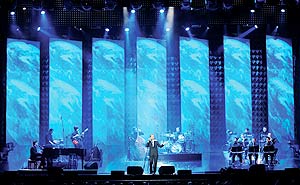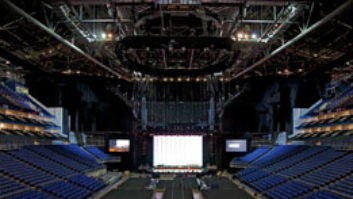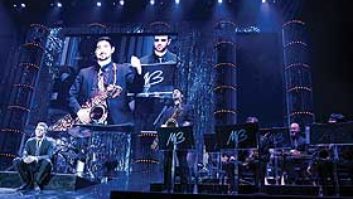
Photo: Steve Jennings
Michael Bublé is just about to step on the stage at the HP Pavilion in San Jose, Calif., for his 115th (or so) show during his Call Me Irresponsible tour, and by all appearances he doesn’t have a care in the world. Granted, having a world-class voice and stellar live band helps, but audio folks know that an artist’s comfort level onstage rests in the front-of-house and monitor engineers’ able hands. Front-of-house mixer Craig Doubet joined Bublé’s tour in June 2007 after touring with legendary singers such as k.d. lang and Luis Miguel. “I am a singer’s mixer,” Doubet says. “That’s what I do. I enjoy painting the music around the voice.”
Bublé’s tour carries a P.A. provided by Montreal-based Solotech, including 32 Meyer Sound MILOs for the main array, 24 MICAs for side hangs and eight M3D subs, as well as a handful of CQ1s and M1Ds for fills. The P.A. is driven with three Meyer Galileo processors tied to a SIM 3 audio analyzer. The SIM 3 is put in place to tune the system every day, but Doubet doesn’t use any kind of analyzers during the show. Rather, he uses a pair of Meyer HD1s set above the Digidesign D-Show Profile to monitor the mix. “I’ve never had to use headphones,” he reports. “With these, you can solo stuff and it pops up right in front of you, a little louder than the room, or you can pop the mix up to make sure.”
In fact, he explains, the combination of the SIM 3 system with the HD1s provides a better representation of the live mix. “You’re usually not in the best-sounding place in the room,” he says of the FOH position. “It’s very reverberant in the middle of an arena, in the middle of the floor. Nobody else hears that, especially on the sides; they are hearing a very dry, direct sound. So having that reference is very useful.”
The Meyer boxes were an important pickup, says Doubet, because of the vocalist’s range. “He has a very interesting voice that is smooth and deep. He can be very deep when he wants to be, and that’s a challenge in lots of rooms because he hits the frequencies where the room goes. So it’s good to have really good control over the array and be able to isolate that and make it as clean as possible so that it just doesn’t go nuts when he gets low.”
A string of processors also helps Doubet keep control over Bublé’s range. The artist sings into a Shure Beta 87C, which helps because he likes to move the mic up and down his body during a show. That signal goes into the D-Show’s built-in Digidesign preamp and through a Sony Oxford GML EQ plug-in, Focusrite Forte Suite plug-in and a TC Electronic DVR2 Digital Vintage Reverb plug-in. Outboard gear includes a BSS 901 compressor and a Lexicon 480L reverb.
Doubet also uses Drawmer Tour Pack plug-ins for the band, which comprises an eight-piece horn section, a bass player, two guitarists (one also plays keys) and a drummer. Fitting the horn section around Bublé’s vocals is a challenge, as is making sure the acoustic bass comes through. “When you’re doing an arena show, it’s important to make it sound like a pop show,” Doubet reports. “It’s got to have some bottom end, it’s got to have some thump. But it’s still an acoustic bass half the time, so there are a couple of pickups and a mic on the bass.” Doubet is taking a direct signal, but the bassist has a cabinet to monitor himself onstage.
As far as mics, Doubet has an interesting assortment that includes a matched pair of DPA 4061s in front of the horn section that’s used for horn tracks, ambience and background vocals; Audio-Technica ATM 350s are placed right on the horns. He also uses the DPAs in the piano with a set of Schertler pickups. Shure KSM 32s mike the guitars, and Neumanns are set up on the drum kit as overheads and on the hi-hats.
MONITORING AT STAGE-LEFT
Monitor mixer Craig Brittain is mixing on a DiGiCo D5 board and uses a speaker to listen to his mixes during most of the show, although everyone but Bublé is on Weston ES2 custom-molded personal monitors. “Because Michael is on wedges, I listen to the cue monitor quite a bit through the night,” Brittain says, “but I definitely put [personal monitors] in a dozen or so times a night to check on mixes.”
Five bandmembers rely on hardwired Shure PSM 600s, while the guitar player who travels down-stage during the show is on a Sennheiser SR3256-C. The bassist has a cabinet behind him that he uses to feel his parts, while the drummer is using a Drum Thumper. Members of the brass section mix their own monitors using Aviom A-16 audio networking mixers. “I send them eight channels of rhythm stems and then a direct node of each one of the horns filling up the other eight,” Brittain explains. “The brass section was a big challenge when I first started with Michael because they are quite meticulous in what they want. I was trying to focus on Michael and it was getting pretty crazy.”
There are five flown Meyer M’elodie boxes per side and four L-Acoustics 115XTs on the stage’s edge. “Michael likes it pretty hot onstage,” Brittain reports, “so there’s a fair bit of life filling the ear mixes from the sidefill going into open mics and whatnot.” The singer gets a lot of vocal in the monitors, as well as whatever he can’t hear acoustically onstage.
The key for Doubet and Brittain is making sure that Bublé is comfortable onstage, night in, night out. “Michael loves to sing off the room,” Doubet says, “so we need to make sure the P.A. is consistent every night and that it’s consistent back to him. If he hears the same thing every night, he can do what he has to do.”
David John Farinella is a San Francisco-based writer.



